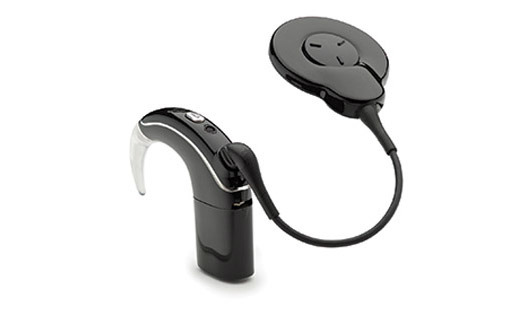Australia-based company Cochlear on Wednesday debuted its latest hearing implant sound processor, the Nucleus 7, which was developed in cooperation with Apple to connect with and integrate sound from iPhone, iPad and iPod touch devices.
Announced in July, but in the works for years, the Made for iPhone sound processor boasts deep integration with Apple technology to deliver iOS device sound output directly to an implant embedded in a user's head.
Apple's accessibility engineering team worked with Cochlear for two to three years to develop a modified Bluetooth Low Energy protocol capable of transferring audio without rapidly depleting the hearing device's battery. Called Bluetooth Low Energy Audio, the Apple patented technology offers extended up time while maintaining high quality audio streams.
As noted by The Australian, Cochlear implant patients looking to connect to iPhone have until now been forced to use a separate Bluetooth accessory. With BLEA, however, owners of the new Nucleus 7 will have direct audio access to phone calls, music, movies and other content on a range of iOS devices.
Unlike traditional hearing aids, the Cochlear system uses a sound processor placed behind an ear to capture sound and translate it into digital signals. These signals are sent to a surgically implanted coil, which decodes the digital information and converts it into electrical pulses that are sent to an electrode array embedded in the cochlea. The pulses stimulate a patient's auditory nerve and the brain perceives this reaction as sound.
Cochlear implants are considered more effective than hearing aids, which simply amplify incoming sound. For users with severe damage to structures in the inner ear, the technology is irreplaceable.
Like most miniaturized electronic devices, sound processors suffer from battery life constraints, making it difficult to implement extra communications hardware like a Bluetooth radio. That's where BLEA comes in.
"We started looking at this program around the concept of Bluetooth LE and how it would be a beneficial tool in this specific circumstance," said Apple director of accessibility Sarah Herrlinger. "The work we have done is applicable both to hearing aids and sound processors."
Herrlinger notes development of the integrated system spanned two to three years with input from multiple hearing aid companies, including Cochlear. The technology is designed to support a wide range of hearing assistance products, as some patients might use a cochlear implant and traditional hearing aid simultaneously.
"We made this work when you may have two different devices, it may even be from two different companies," Herrlinger said.
As the world's first Made for iPhone sound processor, Nucleus 7 comes with a few unique features tied to the company's iOS app. With the app, users an adjust settings and sound processor programs, monitor battery life and access personalized hearing information. The software also boasts a feature similar to "Find My iPhone" that helps users locate a missing sound processor.
Cochlear's Nucleus 7 goes on sale today in Australia.
 Mikey Campbell
Mikey Campbell







-m.jpg)






 Wesley Hilliard
Wesley Hilliard
 Malcolm Owen
Malcolm Owen
 Andrew Orr
Andrew Orr
 William Gallagher
William Gallagher
 Sponsored Content
Sponsored Content
 Christine McKee
Christine McKee

 Thomas Sibilly
Thomas Sibilly






6 Comments
I presume we'll continue to see all kinds of partnerships between Apple and medical devices manufacturers and I think Apple will also dive deeper into healthcare in general. That's where the money is and it's what bedevils a huge number of customers. The potential is limitless once machine vision, artificial intelligence and advanced on-person devices (starting with the Apple Watch) are considered essential for ones wellbeing.
Can anybody recommend a MFi bicros hearing aid?
In case I’m using the wrong description, this set-up is for a person (my mom) deaf in one ear, where the signal from the deaf side is pumped over and into the non deaf side.
Before MFi, she had several bicros units and when she decided to try MFi there were only two makers (neither with bicros) who were MFi certified (as I recall). She tried Starkey and it had a great app and both app (app had a great patented feature that noted ground speed and automatically switched a car filter on/off) and device worked flawlessly but lacked the amplification power she needed.
She went with a competitors unit (only MFi unit with high amplification) and has had to have monthly visits to her audiologist for tuning and adjustment, lots of automatic pairing/unpairing issues, breakage of plastic components in the outer shell, failure of internal components.
Additionally, the device worked poorly with the live listen function in the iPhone. Whether this lack of optimal performance here was related to this manufacturer having a a) peripheral device that could be placed on a table or clipped on a person, and b) a Bluetooth/HDMI device that could be plugged into a TV is unknown to me. (I saw thes peripherals as potentially useful but kinda fiddle and easily lost or forgotten.)
Keep in mind, my mom treats her hearing aids like they are Crown Jewels (they/it cost about 5k$) and typically gave 5 years of service from several sets over 30 years.
There is still a short warranty remaining and we were thinking of pressing for a refund in light of the poor performance.
There are now many manufacturers certified to MFi and if anybody, with similar needs as my mom, can recommend any if the following I would be grateful:
1. Hi amp bicros solution
2. Hi amp single ear solution
3. Either of above also including a channel from mic in hearing aid back to the iPhone. (So she doesn’t always have to tote the phone around the room as she phones.)